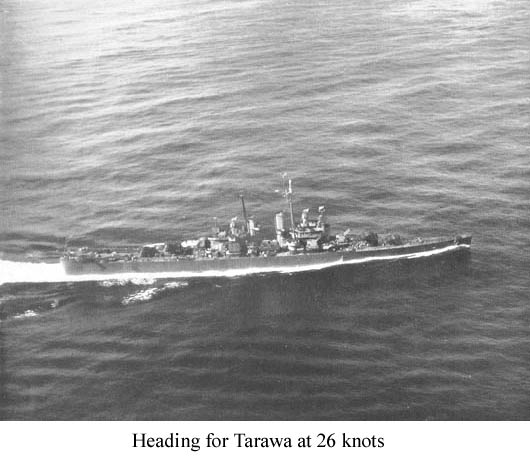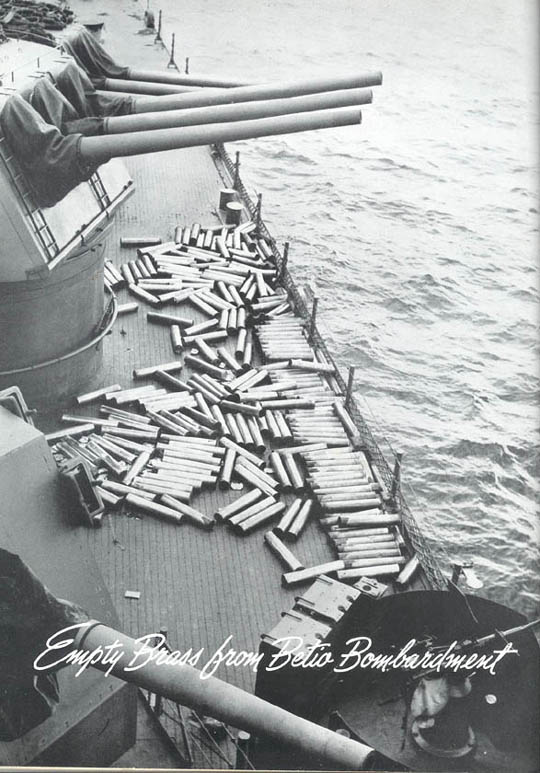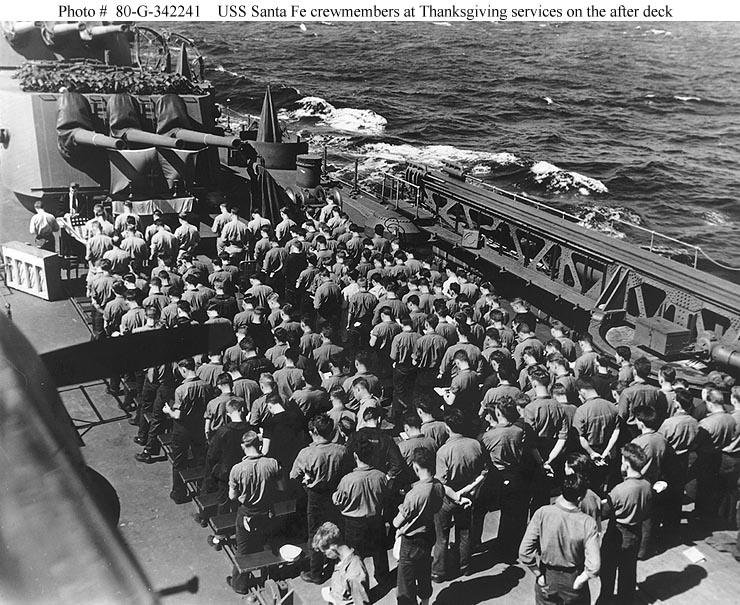|
Limited availability was afforded her at Pearl Harbor, the ship spending 5-8 September in dry-dock. Released to fight again, she became the Flagship of Rear Admiral Laurance Tombs Dubose's Cruiser Division 13 (other cruisers: BIRMINGHAM and MOBILE). Along with carrier Task Force 15, the SANTA FE and her running mates moved out of Pearl Harbor 11 September 1943. Covering carrier-borne aerial thrusts throughout the Pacific was to constitute the SANTA FE's prime wartime activity. |
|
|
|
Tarawa in the Gilbert Islands was Task Force 15's first endeavor. Cruiser SANTA FE fueled 15 September and two days later swept in on the Atoll at 26 knots. Aircraft launched from the three carriers at 0331 on the 18th winged in to maul Tarawa and Makin. Enemy planes failed to locate swift Task Force 15 and it returned to Pearl Harbor unscarred on 23 September 1943. Next on the strike docket was already-historic Wake Island. At Pearl Harbor on 25 September, Task Force 15 was disbanded, Task Force 14 (6 carriers, 2 cruisers and 5 DD divisions) formed. Cruiser Division 13 again rode gun guard on the carriers as headed due west from Pearl Harbor 29 September. On 2 October Task Force 14 split into two groups, the SANTA FE in the northern section. Early on the 5th, Navy bombers swooped away from the flight decks to do a job on Wake's installations. It was a two-way punch, from both sea and air. Closing in on the island from the north, the SANTA FE and her sisters opened up on 5 October at 1249. Captain Berkey made one run westward, then closed to medium range for an eastward leg. Around the SANTA FE the sea frequently erupted with the near misses of artillery positions ashore, and evasive maneuvers were employed twice during the land-sea duel. At 1420 the ships, none of which had been hit, allowed their 6-inch rifles to cool and commenced retirement. Black smudges of smoke lolled on the horizon in testimony to the prowess of SANTA FE gunnery. Wake was hit again by aircraft the next day, whereupon Task Force 14 departed the blackened island pin-point. No further challenge was met during the 5-day return trek to Pearl Harbor, which was over 11 October. Task Force 14 was promptly dissolved and Cruiser Division 13 consigned to Vice Admiral Raymond A. Spruance for duty in the newly-created Central Pacific Force (Fifth Fleet). SANTA FE sailors were to see a year of operations with Spruance's big business corporation, dealing out explosive divide to the harried Japanese. Cruiser Division 13 left Pearl Harbor 21 October to groom, with other fire support units, for the forthcoming U.S. invasion of the Gilberts. No sooner had SANTA FE arrived in the Fiji-New Hebrides training area than she and her Flagship cruiser cohorts, plus Destroyer Division 49 were diverted to help capture Bougainville in the northern Solomons. At Espiritu Santo the force fueled 4 November, then made a high-speed passage to Tulagi Island's jungle-encompassed Purvis Bay. Rendezvous was made 7 November with an echelon of reinforcements ear-marked for Cape Torokina (bulge on Bougainville's upper side adjacent to Empress Augusta Bay). Reaching the Cape on 9 November, the three cruisers and four destroyers steamed in an area some 25 miles westward while the troops and supplies were put ashore. Dead set on getting through to the soft cargo-transports Pouring U.S. men and weapons onto Cape Torokina, better than two dozen enemy twin-engined bombers pounced on the watch dogs at nightfall. Lightning flashed in the stormy night sky off Empress Augusta Bay as the Japanese whipped in from two directions to skip-bomb and torpedo their way through a succession of fierce attacks. Among the rapid-firing cruisers and destroyers of the SANTA FE's group, hit enemy aircraft fell into the sea, with as many as eight burning simultaneously on the surface. After two hours, the Japanese temporarily called it quits and returned to Rabaul. November 9th was barely one hour old when they came buzzing back in force, bent on cracking this naval bulwark. Cruiser BIRMINGHAM, who had remained in the zigzagging formation despite one torpedo gash in her port bow and another in her stern, took a bomb blast in her No. 4 turret. Frustrated by the radical maneuvering and crack shooting of Admiral DuBose's cruisers, their sightings thrown way, off by intermittent rain squalls, the few Japanese planes still aloft turned tail and fled With her automatic fire , the SANTA FE had bagged three of the many planes destroyed during the fray outside Empress Augusta Bay; fragments from one victim had sprayed her decks when he crashed close aboard. Captain Berkey's gunners had come into their own. Mission accomplished., CruDiv13 and DesDiv49 left with the emptied transports later on the 9th. While the ships were heading full tilt for Purvis Bay, saccharin-voiced Tokyo Rose took to the ether. Rose cooed the Imperial Air Force's admission that 15 of its planes had been lost, in the night, action at Empress Augusta, then gave it an I-told-you-so ring as she enumerated the U.S. losses: 3 battleships, 2 aircraft carriers, 7 cruisers, 13 destroyers, an unknown number of transports. "This would make the BIRMINGHAM a one-ocean Navy," said the damaged cruiser's Captain (now Rear Admiral) Thomas Browning Inglis, "for it was the only ship that's suffered even a hit. Tokyo Rose is really a comedienne." Weighing anchor in Purvis Bay 12 November 1943, the SANTA FE was on the go again. She fueled on the 13th at Espiritu-Santo, and three days later rejoined the huge amphibious task force involved in the seizure of Tarawa Atoll. Cruiser Division 13 (less the crippled BIRMINGHAM) encountered no enemy opposition as they approached Tarawa on the night of 19-20 November. With orders to throw a wrench in Japanese flight operations, the SANTA FE, patrolled southwest of the atoll's coral-coated fortress of Betio early on 20 November. |
|
|
|
At 0521 she opened up with counter battery fire and at 0627 chimed in with other fleet heavies in the scheduled pre-invasion bombardment of Betio Island. USS SANTA FE's 6-inch guns drilled flaming steel into thick concrete bunkers until 0855. Bathing in the limelight was Lieutenant (jg) Theodore T. Buzanoski, USNR who flew one of the SANTA FE's Kingfishers in over Tarawa to relay topographical information and locations to her bridge. Spotting a Japanese ammunition dump, he departed from his usual role and jerked the bomb release lever. Scout Pilot Buzanoski watched with satisfaction as his target skyrocketed in flame. Strikes by carrier-aircraft and naval artillery had been effective in tearing Tarawa's above-ground installations apart. However the time interval between the lifting of the final bombardment and the arrival of the first Marine assault wave was too great, this caused by unexpected current which carried the landing craft out of their designated area, the slowness of the assault boats themselves, and difficulty with the depth of the water at the outer reef. Lack of covering fire at the critical time of landing resulted in heavy losses. Despite sharp opposition and 20. percent casualties, Major General Julian C. Smith's leathernecks overran Betio. Cruiser SANTA FE rendered call fire support 21-22 November, retiring at night to screen the transports. Systematically reducing blockhouses with TNT charges, flame-throwers and bangalore torpedoes, the invaders squeezed the bandy-legged defenders into the western end of the island, then slaughtered them as they tried to Banzai their way out of the trap. Up over bloody Betio went the Stars and Stripes.
|



